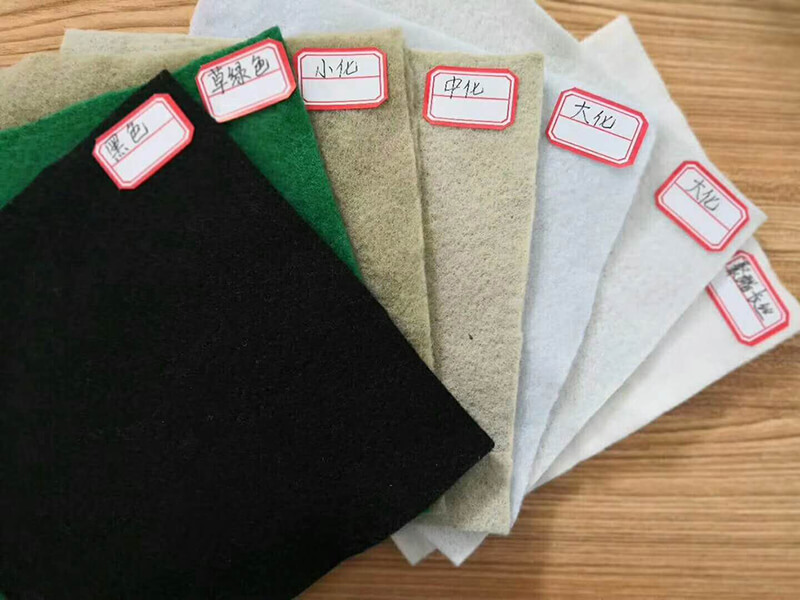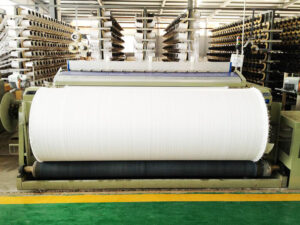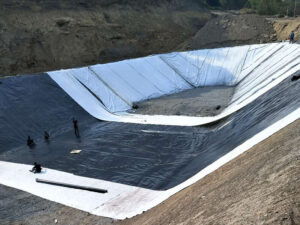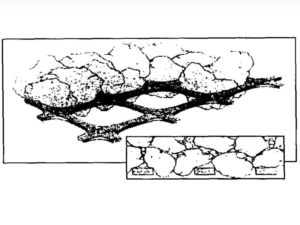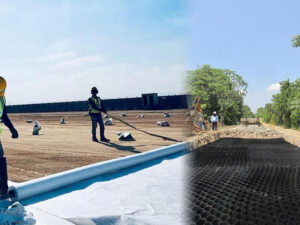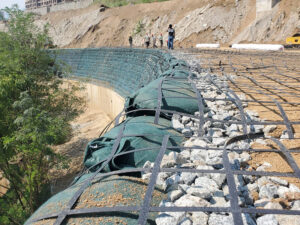Geotextile is a single water-permeable material made of polymer as raw material and produced by non-woven process, weaving processes, weaving processes, wet-laid processes, etc. It can be divided into different types of geotextiles according to different methods. In this article, QIVOC will introduce the types of geotextile fabrics in detail.
Geotextiles can be classified into the following types according to different manufacturing methods.
1. Woven geotextile is a geotextile woven by synthetic fiber filaments (polypropylene, polyester, nylon, nylon, ethylene, etc.) or plastic flat filaments and plastic split filaments arranged in a certain direction.
2. Non-woven geotextile is a fabric made of thin mats of short fibers or filaments arranged randomly or directionally, which are mechanically bonded, thermally bonded or chemically bonded.
3. Wet-laid geotextiles are made from chopped polyester fibers and glass fibers dispersed in water, followed by processes such as extraction, dehydration, sizing, and drying.
4. Composite geotextile:
It is a geotextile compounded by needle punching of filament woven geotextiles or split filament woven geotextiles (woven geotextiles) made of polymers and short fiber needle punched nonwoven geotextiles. It has the functions of protection and reinforcement and is mainly used in engineering fields such as soft soil foundation reinforcement and embankment base reinforcement. According to the product structure, it is divided into two-layer composite and three-layer composite.
4.1. Composite geotextile is divided into: according to material composition:
①Filament woven/short fiber nonwoven composite geotextile
②Split yarn woven/short fiber nonwoven composite geotextile
③Plastic flat wire braid/short fiber non-woven composite geotextile
④Short fiber nonwoven/filament woven/short fiber nonwoven composite geotextile
⑤Short fiber nonwoven/split yarn woven/short fiber nonwoven composite geotextile
⑥Short fiber nonwoven/plastic woven flat weave/short fiber nonwoven composite geotextile
Geotextiles filter fabric can be divided into the following categories according to their different functions.
Drainage and reverse filter geotextile:
Geotextiles allow liquids and gases to pass vertically while keeping the soil skeleton particles affected by the penetration force from being lost. Some geotextiles also serve as lateral drainage channels.
Drainage and anti-filtration geotextiles are mainly used for slope protection, retaining walls or anti-filtration layers behind retaining walls, drainage blind ditches, soft foundation treatment and other projects. It can be used as the outsourcing material for a geosynthetic filter layer, bagged sand and gravel filter layer, soft permeable pipe, plastic drainage belt, bagged sand well or composite geomembrane.
Wrapped geotextile:
Geotextiles are used as a wrapper for loose soil, sand, and stone or as a carrier for concrete and mortar to form blocks of a certain volume and shape, and are used for slope protection, scour protection and other projects.
Wrapped geotextile products mainly include geo bags, geomembrane bags, and geotube bags. The geotextiles in the bagged sand-cobbled gravel filter layer and bagged sand wells all have wrapping functions.
Isolation geotextile:
Geotextiles are laid between different media to prevent adjacent different media from mixing.
Isolation geotextiles are mainly used to isolate fillers of different particle sizes in embankments or to lay geotextiles on soft soil surfaces to avoid clogging the upper drainage cushion.
Reinforced geotextile:
The geotextile with a certain tensile strength is buried in the soil and relies on its interaction with the soil interface to improve the strength and stability of the soil and limit the displacement of the soil.
Reinforced geotextiles are mainly used in projects such as reinforced soil structures and reinforced cushions in soft foundation treatment, or combined with geomembranes to form reinforced composite geomembranes.
Geotextiles can be divided into the following types according to different material types:
1. Polyester staple fiber needle-punched nonwoven geotextile: a geotextile produced using polyester staple fiber as raw material and using non-woven processes such as blowing, carding, netting, and needle punching. Has the following properties:
① Good flexibility, corrosion resistance and oxidation resistance.
② Has good water permeability, filtration and isolation properties.
2. Polypropylene short fiber needle-punched nonwoven geotextile: Made of high-strength and low-elongation polypropylene short fiber as the main raw material and produced by non-woven technology, it has the following properties:
③ Isolation, reinforcement, protection, filtration, drainage, buffering and other functions.
④ The physical and mechanical performance indicators are 2 to 3 times higher than those of polyester geotextiles. Products with the same weight have lower specific gravity, excellent acid and alkali resistance, good hot-melt adhesion, and strong wear resistance.
3. Filament spun-bond needle-punched nonwoven geotextile: Using PET as raw material, it is a geotextile with three-dimensional pores produced by melt spinning, air drafting, oscillating mesh laying, and acupuncture reinforcement. Has the following properties:
① High mechanical index, good creep performance; strong corrosion resistance, excellent aging resistance, heat resistance, and excellent hydraulic properties.
4. Plastic flat wire is woven geotextile: using polypropylene (PP) or polyethylene (PE) as the main raw material, it is produced through drawing, cutting and weaving processes. Has the following properties:
① Lightweight, high strength, small elongation, good integrity, and convenient construction;
② It has the functions of reinforcement, separation, drainage filtration and fence.
5. Split film yarn is woven geotextile: Made of polymer cut film yarn (yarn) and split film yarn (yarn) as raw materials, it is woven using woven technology. With the following properties::
① Lightweight, high strength, small elongation, good integrity, and convenient construction;
② It has the functions of protection, reinforcement, isolation, filtration and drainage.
6. Basalt woven geotextile: a material made of basalt fiber untwisted rovings through woven technology and chemically finished. This product has the following properties:
① It has the advantages of high strength, high modulus, lightweight, chemical resistance, and good high and low-temperature stability, and is widely used in civil engineering, water conservancy construction, aerospace, automobiles and other fields.
7. Composite geotextile: a reinforced composite product with a double-layer structure or a multi-layer structure composed of woven geotextile and non-woven geotextile. Has the following properties:
① High tensile strength, low elongation, uniform longitudinal and transverse deformation, high tear resistance, excellent wear resistance, high water permeability, and excellent filter resistance. It can improve the bearing capacity of soft soil foundations and embankment bases, reduce settlement, and increase foundation stability.
② It has the functions of protection and reinforcement and is mainly used in engineering fields such as soft soil foundation reinforcement and embankment base reinforcement.
8. Polyester glass fiber wet-laid nonwoven fabric: It is made from chopped polyester fiber and glass fiber as raw materials. After being dispersed in water, it is manufactured through processes such as extraction, dehydration, sizing, and drying. Has the following properties:
① It combines the strength of glass fiber and the flexibility of polyester fiber. It has low elongation and high tensile strength and has good wettability and adhesion with asphalt. During construction, it will be combined with the sticky layer of hot asphalt to form a special stable layer structure, which is well bonded with the upper and lower layers and plays a role in stress dispersion and waterproofing. It can effectively eliminate stress concentration at pavement joints or cracks, reduce the spread of cracks in the pavement layer, and effectively improve the fatigue resistance of the surface layer.
② Mainly used in highway projects such as cement concrete pavement reconstruction, old road reconstruction and expansion, asphalt concrete overlay, semi-rigid base shrinkage crack treatment, bridge deck waterproof layer, municipal road covering, etc.
According to the use of geotextiles, can be divided into the following categories.
1. Types of geotextiles used for filter layers and drainage parts:
Utilizing the characteristics of good water permeability and small pores of geotextile, it can be used as drainage and filter body for earth-rock dams, sluices, embankments, retaining walls and other projects. It allows the seepage water to pass through the reverse filter body smoothly, effectively reduces the infiltration line, reduces the seepage pressure, effectively protects the stability of particles in the soil, and improves the stability of the dam slope. The materials are generally designed as filament woven geotextiles, anti-aging polypropylene flat filament woven geotextiles, woven/nonwoven composite geotextiles, etc.
2. Types of geotextiles used for bank protection and anti-scouring areas:
In order to prevent water flow from scouring channels and coastal slopes. The types of protective geotextiles mainly include polyester staple fiber needle-punched nonwovens, filament spunbond needle-punched nonwoven geotextiles, filament woven geotextiles, split filament woven geotextiles, etc. According to the specific requirements of the project, the above materials are made into products that meet certain specifications and can be used for temporary projects or permanent protection of water and underwater parts. The specific types are as follows:
Ø Earthbag: A bag made of woven geotextile, similar to a straw bale, filled with earth material. It can be used for ballast, plugging caves, filling vortices and collapses.
Ø Soil pillow: It is a long soil bag, the diameter can be 0.4m~1.0m, the length can be determined according to the project requirements, filled with soil and sand, it can be used as a long strip to weigh, or as a component of the dam facing the water surface.
Ø Soft rows: Large-area rows made of single-layer or double-layer filament woven geotextiles and split film yarn woven geotextiles, which can replace traditional firewood rows. It can play the role of reverse filtration and drainage and effectively prevent erosion. It can also be made into larger area geomembrane rows.
Ø Geoform bag: made of double-layer polypropylene filament woven geotextile, filled with concrete or mortar, and solidified to form a protective block.
Ø Ecological bags and planting bags: made of polypropylene short fiber needle punched nonwoven geotextile and filament spunbond needle punched nonwoven geotextile.
It is processed into open-mouth bags of a certain size, filled with planting soil, fertilizer, etc., and laid on slopes with poor soil to form products that can restore or create new ecosystems. According to the design service life, slope erosion conditions, etc., they can be divided into plant bags, ecological bags, etc.
3. Types of geotextiles used for soil reinforcement and reinforcement parts:
The high tensile modulus of polypropylene filament woven geotextiles and woven/nonwoven composite geotextiles are used as reinforcements. Lay certain reinforcements in a certain direction in the soil to increase the shear strength, tensile strength and integrity of the soil.
In the end
The above is an introduction to the types of geotextile fabric. I believe that through this article, you will have a better understanding of the types of geotextiles. Of course, if you have any more questions, please feel free to contact us via email.

